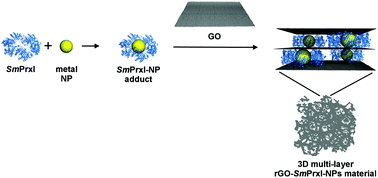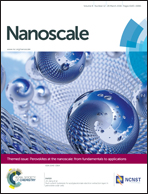Supramolecular self-assembly of graphene oxide and metal nanoparticles into stacked multilayers by means of a multitasking protein ring†
Abstract
Graphene oxide (GO) is rapidly emerging worldwide as a breakthrough precursor material for next-generation devices. However, this requires the transition of its two-dimensional layered structure into more accessible three-dimensional (3D) arrays. Peroxiredoxins (Prx) are a family of multitasking redox enzymes, self-assembling into ring-like architectures. Taking advantage of both their symmetric structure and function, 3D reduced GO-based composites are hereby built up. Results reveal that the “double-faced” Prx rings can adhere flat on single GO layers and partially reduce them by their sulfur-containing amino acids, driving their stacking into 3D multi-layer reduced GO-Prx composites. This process occurs in aqueous solution at a very low GO concentration, i.e. 0.2 mg ml−1. Further, protein engineering allows the Prx ring to be enriched with metal binding sites inside its lumen. This feature is exploited to both capture presynthesized gold nanoparticles and grow in situ palladium nanoparticles paving the way to straightforward and “green” routes to 3D reduced GO–metal composite materials.


 Please wait while we load your content...
Please wait while we load your content...